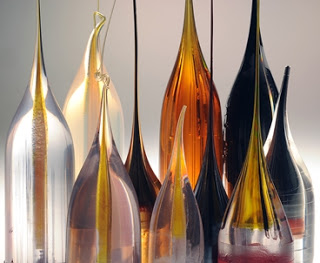Samples of materials that have been made into fibers in the lab of MIT’s Yoel Fink. The initial material is made into a ‘preform,’ in the lower portion, which is then heated and drawn out like taffy into a fiber from the top, preserving the arrangement of materials within the structure.
Photo: Greg Hren/RLEM
Researchers at MIT have succeeded in making a fine thread that functions as a diode, a device at the heart of modern electronics. This feat — made possible by a new approach to a type of fiber manufacturing known as fiber drawing — could open up possibilities for fabricating a wide variety of electronic and photonic devices within composite fibers, using a variety of materials.
The synthesis of a high-melting temperature semiconductor in a low-temperature fiber drawing process is demonstrated, substantially expanding the set of materials that can be incorporated into fibers. Reagents in the solid state are arranged in proximate domains within a fiber preform. The preform is fluidized at elevated temperatures and drawn into fiber, reducing the lateral dimensions and bringing the domains into intimate contact to enable chemical reaction. A polymer preform containing a thin layer of selenium contacted by tin–zinc wires is drawn to yield electrically contacted crystalline ZnSe domains of sub-100-nm scales. The in situ synthesized compound semiconductor becomes the basis for an electronic heterostructure diode of arbitrary length in the fiber. The ability to synthesize materials within fibers while precisely controlling their geometry and electrical connectivity at submicron scales presents new opportunities for increasing the complexity and functionality of fiber structures.
Nicholas Orf, a postdoctoral researcher at MIT who was lead author of a paper describing the synthesis of materials inside a fiber. He is holding samples of fibers produced in the lab. Photo: Melanie Gonick
Fiber-drawing techniques are used to produce the optical fibers behind much of today’s broadband communications, but these techniques have been limited to materials that can partially melt and stretch like taffy at the temperatures being used for drawing the fibers. The new work demonstrates a way of synthesizing new materials during the fiber-making process, including materials whose melting points are far higher than the temperatures used to process the fibers. The simple proof-of-concept demonstration carried out by the MIT researchers could open the door to a wide array of sophisticated devices based on composite fibers, they say.
All previous work on fiber-drawing ended up with the same materials that were there to begin with, just in a different shape, Orf says, adding: “In this method, new materials are formed during the drawing process.”
Fiber drawing involves preparing a “preform” of materials, such as a large glass rod resembling an oversized model of the fiber to be produced. This preform is heated until it reaches a taffy-like consistency and then pulled into a thin fiber. The materials comprising the preform remain unchanged as its dimensions are drastically reduced.
In the current research, the preform contained selenium, sulfur, zinc and tin, arranged within a coating of polymer material. The drawing process, carried out at a temperature of just 260 degrees Celsius (500 degrees Fahrenheit), combined these materials to form fibers containing zinc selenide, even though that compound has a melting point of 1,530 degrees Celsius (2,786 degrees Fahrenheit).
The resulting fiber was a simple but functional semiconductor device called a diode — a sort of one-way valve for electrical current, allowing electrons to flow through it in only one direction. The diode, never before made by such a method, is a basic building block for electrical circuits.
“This shows that many more kinds of materials can be incorporated into fibers than ever before,” Orf says. Because the physical arrangements placed in the preform are preserved in the drawn fiber, it should ultimately be possible to incorporate more complex electronic circuits within the structure of the fiber itself.
Such fibers might find uses as sensors for light, temperature or other environmental conditions, Orf says. Or the fibers could then be woven, such as to make a solar-cell fabric, he says.
4 pages of supplemental material
If you liked this article, please give it a quick review on ycombinator or StumbleUpon. Thanks

Brian Wang is a Futurist Thought Leader and a popular Science blogger with 1 million readers per month. His blog Nextbigfuture.com is ranked #1 Science News Blog. It covers many disruptive technology and trends including Space, Robotics, Artificial Intelligence, Medicine, Anti-aging Biotechnology, and Nanotechnology.
Known for identifying cutting edge technologies, he is currently a Co-Founder of a startup and fundraiser for high potential early-stage companies. He is the Head of Research for Allocations for deep technology investments and an Angel Investor at Space Angels.
A frequent speaker at corporations, he has been a TEDx speaker, a Singularity University speaker and guest at numerous interviews for radio and podcasts. He is open to public speaking and advising engagements.



